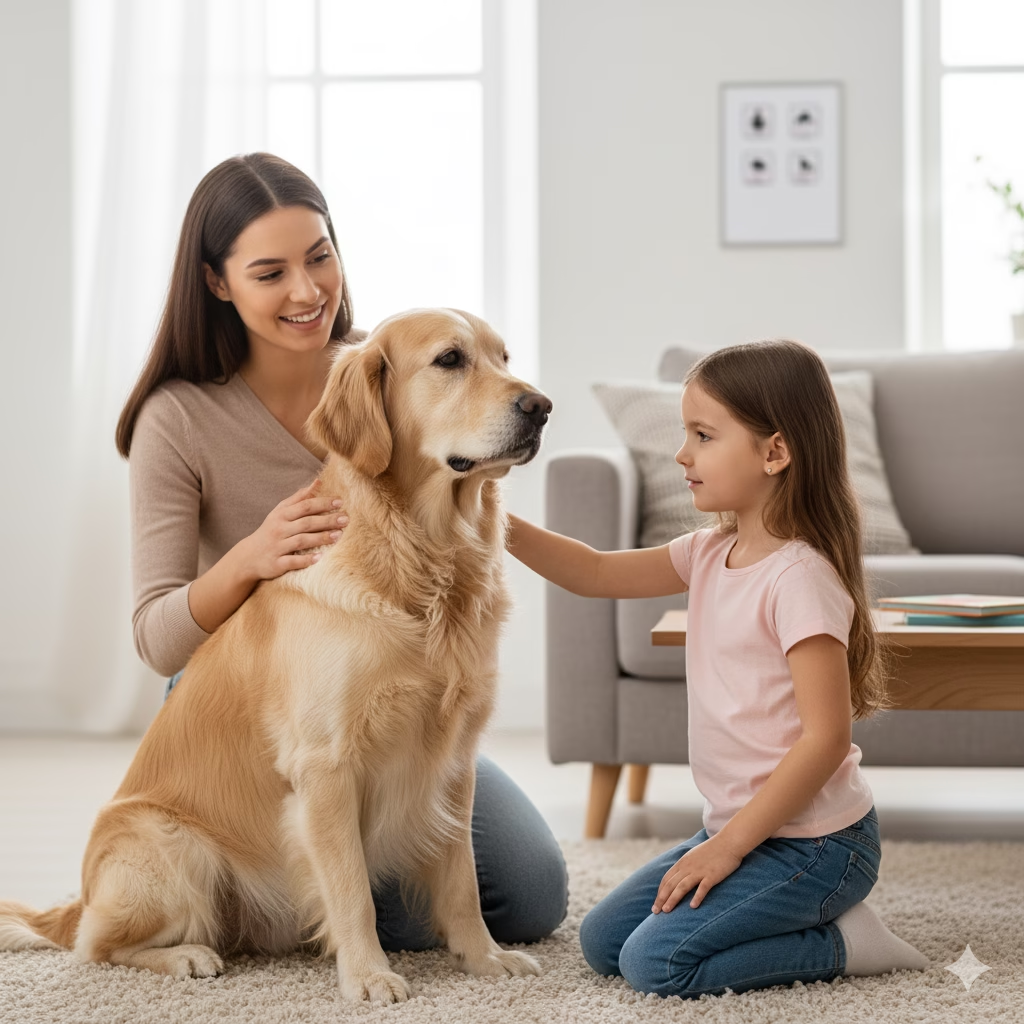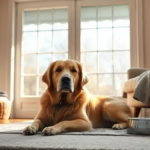The Unspoken Agreement: Building a Language of Respect
I think one of the most common misconceptions new “dog families” have is that a Golden Retriever’s gentle nature is a failsafe. We choose them precisely for their legendary patience and tolerance, and we assume that this temperament is a built-in guarantee of safety around our children. While their disposition is a massive advantage, I’ve learned that true safety isn’t based on the dog’s patience alone; it’s built upon an unspoken agreement of mutual respect between dog and child. And as the parent, you are the architect and translator of that agreement.
The goal was never to make my children fearful of our dog, Max. Quite the opposite. I wanted them to have a relationship free of fear—both for my kids and for Max. A child who understands a dog’s boundaries is a safer child. A dog who feels understood and respected is a calmer, more predictable companion. What I’m sharing with you today aren’t just rules to prevent a bite; they are the foundational principles we used to build a common language of trust and respect in our home. This is how we moved beyond simply co-existing and created a truly safe, harmonious bond.
The Foundation: Seeing the World from Four Paws Down
Before we can teach our children how to act, we have to help them understand why. The single most important concept I taught my kids was that Max doesn’t think like a human. Actions that mean “I love you” in our world—like a tight, squeezy hug or a kiss directly on the face—can feel threatening or confining in the canine world. Understanding this fundamental difference is the key to empathy and safety.
The Critical Concept of a Dog’s Personal “Bubble”
The first lesson in our home was about “Max’s Bubble.” This is his personal space, and it must be respected. Just like we don’t like people getting right in our face without permission, dogs need their own space to feel secure. For Max, his bubble includes a few sacred zones:
- His Crate/Bed: This is his den, his bedroom, his safe haven. The number one rule in our house is that when Max is in his bed, he is “invisible.” We don’t bother him, we don’t reach in to pet him, and we certainly don’t try to climb in with him. It gives him an essential escape route, a place he knows he can go to if the chaos of family life becomes too much. This single rule prevents a dog from ever feeling cornered, which is a common precursor to a defensive reaction.
- His Food and Water Bowls: Mealtime is a vulnerable time for any animal. I taught my kids that when Max is eating or drinking, we give him a wide berth. We don’t pet him, we don’t try to “share” our food with him, and we don’t touch his bowl. This prevents any potential for resource guarding, an instinct even the sweetest Golden can possess.
Learning to Read the Signs: What Your Golden is Really Saying
A dog’s primary form of communication isn’t barking; it’s their body language. Teaching your child to recognize a few basic signals is like giving them a superpower. It transforms them from a potential agitator into an empathetic friend. We turned this into a game of “What is Max feeling?”
Here are the simple cues I taught my kids:
- A Happy, Relaxed Dog: A soft, wiggly body, a gently sweeping tail, relaxed ears, and a soft mouth (maybe even a “smile”). This is a green light for gentle interaction.
- A Stressed or Uncomfortable Dog (The Yellow Light): This is the most important category. These are the subtle pleas for space.
- Lip Licking: When he isn’t eating or drinking.
- Yawning: When he isn’t tired.
- “Whale Eye”: When you see the whites of his eyes in a crescent shape.
- Tucked Tail: A low or tucked tail indicates fear or anxiety.
- Turning His Head Away: He is actively trying to avoid the interaction.
When my kids see these “yellow lights,” they know it’s time to immediately give Max some space. It’s not a rejection; it’s a polite request that we have taught them to honor.
The “Golden Rules” of Interaction: Our 5 Family Commandments
With that foundation of understanding, I introduced five clear, non-negotiable rules for how we physically interact with Max. We have them on a chart on our fridge. They are simple, direct, and have become second nature in our home.
1. Permission First, Always.
We teach our kids to ask permission before touching another person, and the same applies to our dog. Even though Max is part of our family, we taught our children to treat every interaction as an invitation.
How We Do It: We use the “Pat, Pet, Pause” method. The child is taught to first gently pat their own leg to invite the dog over. If Max comes, they can gently pet him along his back or chest for a few seconds. Then, they pause. If Max leans in for more, wags his tail, and shows he’s enjoying it, they can continue. If he turns or walks away, the interaction is over. This empowers the dog to have a choice, and it teaches the child the invaluable lesson of consent.
2. Let Sleeping (and Eating) Dogs Lie.
This is a classic for a reason. A dog startled from a deep sleep can react defensively out of sheer reflex. Similarly, as mentioned before, a dog enjoying a meal or a high-value chew (like a bone) should be left in complete peace.
How We Do It: This is a zero-tolerance rule. “If Max’s eyes are closed, our hands are closed.” For mealtime, we physically manage the environment. Max eats in the kitchen while we eat at the dining table, with a baby gate often separating the spaces in the early years to remove any temptation for the kids to wander over.
3. We Are Gentle and Kind.
“Be gentle” can be too vague for a young child. I had to break it down into very specific, physical actions. We practiced these movements on a stuffed animal first before ever trying them on Max.
- Where We Pet: I taught them to use a soft, open hand (a “nice hand”) and pet Max on his chest, shoulders, and back. I explained that, unlike us, most dogs don’t enjoy being patted on the top of the head or having someone’s face right in their own.
- What We NEVER Do: We have a clear list of “no-fly zones.” No pulling ears. No grabbing his tail. No poking his eyes. No climbing or riding on him. I explained that these actions can hurt him and make him feel scared, and we never want our best friend to feel scared.
4. Voices Inside, Not Outside.
Children are naturally loud and excitable, but high-pitched squealing and screaming can quickly overstimulate a dog. An over-aroused Golden is more likely to start jumping, nipping, and exhibiting frantic behavior that can be dangerous around a small child.
How We Do It: When playtime starts to get too loud and rowdy inside, I call for a “calm break.” We all take a few deep breaths, maybe grab a drink of water, and let the energy level come down. I explain to the kids, “Max is getting too excited with our loud voices. Let’s use our quiet voices so he can stay calm and keep playing with us.” This connects their behavior directly to the outcome they want (more playtime).
5. Dog Toys and Kid Toys Live in Different Worlds.
To a dog, a stuffed unicorn looks and feels a lot like a stuffed squeaky squirrel. It’s unfair to expect them to magically know the difference. Likewise, a child might see a fun-looking rope toy and want to claim it as their own. This confusion is a recipe for conflict.
How We Do It: We established very clear boundaries from day one. Max’s toys live in a specific basket in the living room. The kids’ toys live in their playroom or bedroom. The kids are not allowed to take a toy from Max’s basket, and more importantly, they are strictly forbidden from ever trying to take a toy directly from his mouth. If he picks up one of their toys by mistake, their job is to come and tell me immediately. I then perform a “trade” with a high-value treat, making the exchange a positive experience for everyone.
Conclusion: Safety Isn’t a Limitation; It’s a Liberator
It may seem like a lot of rules, but in practice, they blend seamlessly into the background of our daily lives. They have become our family’s culture. And the result isn’t a stiff, overly-cautious relationship. It’s the exact opposite. Because my children understand Max and Max feels safe and respected by them, their bond is more relaxed, more authentic, and more joyful.
These rules didn’t put walls between them; they built a bridge of understanding. And on that bridge, a truly beautiful, safe, and unbreakable friendship has been built.
A Real-Life Tip: My single most effective safety technique is a simple one I call “Be a Tree.” I taught my kids that if Max (or any dog) ever gets too jumpy and excited around them, they should stop moving instantly, “grow roots” by standing still, “fold their branches” by crossing their arms over their chest, and look down at their feet. A dog’s excitement is fueled by movement and engagement. By becoming a boring, motionless “tree,” they instantly diffuse the dog’s energy. He quickly loses interest and calms down. It’s a simple, memorable action that gives them power and control in an overwhelming situation.

Rafael Souza is a digital marketing strategist and lifelong dog enthusiast. Passionate about Golden Retrievers, he shares practical, research-based tips to help owners provide healthier and happier lives for their furry companions.





